Parameters for one health genomic surveillance of Escherichia coli from Australia
- PMID: 39747833
- PMCID: PMC11696363
- DOI: 10.1038/s41467-024-55103-2
Parameters for one health genomic surveillance of Escherichia coli from Australia
Erratum in
-
Publisher Correction: Parameters for one health genomic surveillance of Escherichia coli from Australia.Nat Commun. 2025 Apr 7;16(1):3309. doi: 10.1038/s41467-025-58600-0. Nat Commun. 2025. PMID: 40195308 Free PMC article. No abstract available.
Abstract
Genomics is a cornerstone of modern pathogen epidemiology yet demonstrating transmission in a One Health context is challenging, as strains circulate and evolve within and between diverse hosts and environments. To identify phylogenetic linkages and better define relevant measures of genomic relatedness in a One Health context, we collated 5471 Escherichia coli genome sequences from Australia originating from humans (n = 2996), wild animals (n = 870), livestock (n = 649), companion animals (n = 375), environmental sources (n = 292) and food (n = 289) spanning over 36 years. Of the 827 multi-locus sequence types (STs) identified, 10 STs were commonly associated with cross-source genomic clusters, including the highly clonal ST131, pandemic zoonotic lineages such as ST95, and emerging human ExPEC ST1193. Here, we show that assessing genomic relationships at ≤ 100 SNP threshold enabled detection of cross-source linkage otherwise obscured when applying typical outbreak-oriented relatedness thresholds ( ≤ 20 SNPs) and should be considered in interrogation of One Health genomic datasets.
© 2024. The Author(s).
Conflict of interest statement
Competing interests: The authors declare that there are no conflicts of interest regarding the generation and publication of this manuscript.
Figures
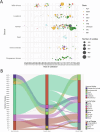
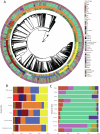
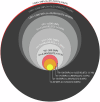
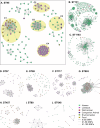
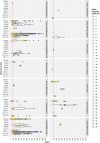
Similar articles
-
Comparative Genomic Analysis of Globally Dominant ST131 Clone with Other Epidemiologically Successful Extraintestinal Pathogenic Escherichia coli (ExPEC) Lineages.mBio. 2017 Oct 24;8(5):e01596-17. doi: 10.1128/mBio.01596-17. mBio. 2017. PMID: 29066550 Free PMC article.
-
Genomic surveillance of Escherichia coli in municipal wastewater treatment plants as an indicator of clinically relevant pathogens and their resistance genes.Microb Genom. 2019 May;5(5):e000267. doi: 10.1099/mgen.0.000267. Epub 2019 May 20. Microb Genom. 2019. PMID: 31107200 Free PMC article.
-
Genomic and Temporal Trends in Canine ExPEC Reflect Those of Human ExPEC.Microbiol Spectr. 2022 Jun 29;10(3):e0129122. doi: 10.1128/spectrum.01291-22. Epub 2022 Jun 8. Microbiol Spectr. 2022. PMID: 35674442 Free PMC article.
-
Pandemic lineages of extraintestinal pathogenic Escherichia coli.Clin Microbiol Infect. 2014 May;20(5):380-90. doi: 10.1111/1469-0691.12646. Clin Microbiol Infect. 2014. PMID: 24766445 Review.
-
Global Extraintestinal Pathogenic Escherichia coli (ExPEC) Lineages.Clin Microbiol Rev. 2019 Jun 12;32(3):e00135-18. doi: 10.1128/CMR.00135-18. Print 2019 Jun 19. Clin Microbiol Rev. 2019. PMID: 31189557 Free PMC article.
Cited by
-
Zoonotic potential of uropathogenic Escherichia coli lineages from companion animals.Vet Res. 2025 Mar 26;56(1):69. doi: 10.1186/s13567-025-01493-0. Vet Res. 2025. PMID: 40140916 Free PMC article.
References
-
- Djordjevic, S. P. et al. Genomic surveillance for antimicrobial resistance—a One Health perspective. Nat. Rev. Genet.25, 142–157 (2024). - PubMed
-
- Nagy, B. & Fekete, P. Z. Enterotoxigenic Escherichia coli in veterinary medicine. Int. J. Med. Microbiol.295, 443–454 (2005). - PubMed
-
- Nagy, B. & Fekete, P. Z. Enterotoxigenic Escherichia coli (ETEC) in farm animals. Vet. Res30, 259–284 (1999). - PubMed
Publication types
MeSH terms
Grants and funding
LinkOut - more resources
Full Text Sources
Medical

